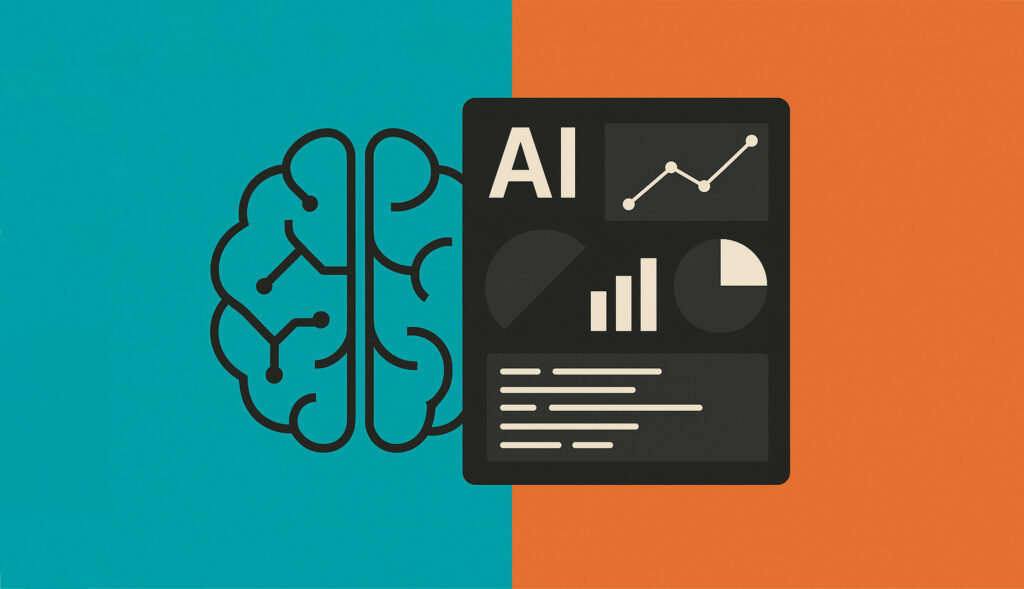Why AI won’t replace change practitioners—but it will demand they evolve.
Artificial intelligence is redefining the way organisations operate, make decisions and interact with their people. Its impact on change management—the discipline tasked with ensuring people adopt change effectively—is no exception. But as AI capabilities grow, so too does the question: is AI a tool that augments the work of change practitioners or a disruptive force that will eventually replace them?
The answer is both simpler and more nuanced than many assume. AI is neither saviour nor destroyer—it’s a multiplier. For organisations that understand how to integrate AI thoughtfully, it enhances the change process. For those that don’t, it risks widening existing capability gaps and creating even greater change resistance.
The Promise of AI in Change Management
AI brings undeniable utility to the change management toolkit. From natural language processing tools that surface themes in stakeholder feedback to machine learning models that predict employee sentiment trends, AI has the potential to enhance decision-making, accelerate timelines and reduce manual effort.
Practitioners can now use AI to generate communication drafts, build change impact assessments or simulate training adoption curves. It enables faster iteration and provides a layer of intelligence that helps identify resistance patterns before they escalate. Tools like Prosci’s AI-enhanced diagnostics are early examples of how data science can improve change readiness evaluations and stakeholder engagement plans.
AI also addresses a long-standing weakness in change programs: the lack of sustained measurement. With real-time dashboards and predictive analytics, organisations can move beyond post-implementation surveys and instead track adoption health in ongoing, meaningful ways.
The Risk of Over-reliance
Yet, while AI’s promise is significant, the risk of overreliance is equally real. Change management is not just about information, it’s about influence. It’s not only about identifying resistance but earning trust and building credibility. And these are domains where human judgment, emotional intelligence and contextual awareness remain irreplaceable.
Change often fails when it’s seen as a technical rollout rather than a people journey. AI can tell us who’s disengaged. It can’t sit with them over coffee and shift their perspective.
The danger is in mistaking acceleration for effectiveness. A flawlessly generated communication pack, if not grounded in the lived experiences of the target audience, may do little to improve adoption. Leaders who lean too heavily on dashboards and sentiment scores risk missing the nuance behind resistance—be it cultural, personal or political.
What AI Can and Can’t Do
To understand AI’s role in change management, it helps to break down the core capabilities of the function and where AI fits.
| Change Management Capability | AI Application | Human Practitioner Role |
| Stakeholder analysis | Data pattern recognition, sentiment | Relationship mapping, influence strategy |
| Communications | Drafting, tone checks, scheduling | Tailoring, storytelling, face-to-face engagement |
| Training | LMS personalisation, quiz generation | Facilitation, feedback loops, coaching |
| Change impact assessment | Process mapping, data tagging | Contextual interpretation, cross-functional input |
| Resistance management | Trend spotting, issue escalation | Trust-building, coaching, listening |
AI can inform. It can accelerate. But it cannot lead. And in change management, leadership—not automation—is what drives results.
Change Management’s Own Identity Crisis
AI’s emergence also exposes an underlying issue within the discipline itself. For too long, change management has suffered from inconsistent definitions, varying levels of maturity across industries and an unfortunate reputation for being “warm and fuzzy.”
Many senior leaders still struggle to articulate what change managers do, beyond “communications and training.” This creates a vulnerability. If leaders don’t understand the strategic value of change, it’s much easier to cut that line item when AI tools promise to do it faster.
To thrive in an AI-enhanced environment, change practitioners must do more than defend their role—they must elevate it. That means reframing change management as a critical enabler of business outcomes, with measurable impacts on adoption, productivity and risk mitigation.
It also means upskilling. AI fluency is no longer optional. Understanding how to prompt, validate and apply AI outputs responsibly is now part of the job.
Preparing for the Next Phase
Organisations hoping to integrate AI into their change functions should start with three simple questions:
- Where is AI best placed to reduce effort without reducing value? Identify repetitive or data-heavy tasks where AI can augment practitioners’ time.
- Do our change leaders understand the difference between AI-generated insight and strategic engagement? Ensure leadership doesn’t confuse dashboards for dialogue.
- How will we build a culture of ethical, human-centered AI use in change? Invest in training, governance and clear principles for responsible application.
AI won’t kill change management. But it will force it to evolve. Practitioners who cling to rigid frameworks or resist technological integration will find themselves increasingly sidelined. Those who adapt, leveraging AI while doubling down on empathy, judgment and influence, will lead the next era of transformation.
Change has always been about people. AI won’t change that. But it may help us change better.
Want to learn more? It all starts with a conversation. Speak to us here.




